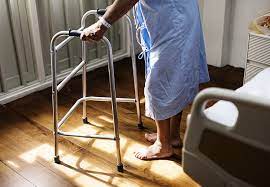Falls in the elderly population are a serious and substantial public health problem. The medical expenditures attributable to both fatal and nonfatal falls in patients 65 years or older approximated $50 billion in 2015.(1) This problem continues to grow as the proportion of people aged 65 years and older increases year after year; projections indicate that the number of persons aged 80 years or older will triple between 2020 and 2050.(2,3) Due to the impending healthcare burden of falls, and subsequent fall-related fractures, researchers have been working hard to develop feasible predictors of fall risk and interventions to reduce fall incidence.
A systematic review of 198 recommendations across 15 guidelines found that risk stratification tools (e.g. STRATIFY Scale), gait/balance assessments, and osteoporosis management are consistently recommended across guidelines to decrease fall burden.(4) In addition to this, a large portion of guideline recommendations involve the intersection of muscle mass and sarcopenia management to reduce falls.
The WHO’s Global Report on Falls Prevention unsurprisingly indicated that elderly individuals with significant muscle weakness are 4.9x more likely to fall.(5) Once combined with their report that fall-related mortality rates increase exponentially with age, it becomes clear that muscle mass and muscle architecture are a critically important variable in fall risk assessment.
Unlike sarcopenia, muscle quality is a relatively new parameter that prioritizes function when assessing muscle mass. Although there is no consensus definition, muscle quality can be defined in the geriatric field as the maintenance of functional autonomy of muscle mass, independent of the quantity.(6) In research, muscle quality is defined by muscle strength or power per unit of appendicular skeletal muscle mass or volume. The emphasis on assessing skeletal muscle quality began after multiple studies demonstrated that loss of muscle strength was a better indicator of functional limitations and mortality than loss of muscle mass.(6,7) Taking this even further, data has shown that muscle strength declines at a greater rate than muscle mass, but not as fast as muscle power.(8) This mismatch in rate of decline suggests that something is happening to the muscle architecture to create these functional changes.
At the tissue and cellular level, impaired protein synthesis, intramuscular lipid infiltration, tissue fibrosis, altered pennation angles, and muscle unit length decreases are all factors that decrease muscle quality with age and sedentation.(9) These changes result in altered strength and power, without necessarily adjusting the cross-sectional area of muscle. These tissue changes further emphasize the importance of using functional measures to determine muscle mass’ impact on fall risk.
“How can we measure muscle quality?” is a contestable topic in current literature, with combinations of functional and qualitative measures being proposed. The most common method involves a strength/power test (e.g. peak quadriceps torque), normalized to a unit of muscle mass or volume. This can be accomplished with computed tomography, magnetic resonance imaging, DXA scan, or ultrasound.(9,10) Newer models are estimating muscle quality through benchmark tests like the Muscle Quality Index (MQI). This test is based on results from a handgrip strength test, chair-stand test, and bioelectrical analysis of muscle to determine muscle quality.(6) These models continue to be refined by less-invasive and cost-effective measures like ultrasound and functional tests, and can be done in a controlled setting that’s safe for the patient.
But how well does muscle quality correlate to fall risk?
An 18-month follow-up study of 167 women aimed to investigate the relationship between muscle quality and fall incidence in community-dwelling women.(10) They found that the rate of falls among individuals with low muscle quality (57.7%) was significantly higher than in those with normal muscle quality (15.3%); decreased muscle quality also correlated with the proportion of “multiple fallers” in the cohort.(10) Another follow-up study performed by the same group using a 3 year follow-up period found that older adults with lower muscle quality and quantity had significantly elevated fall incidence (HR 1.54).(11) Both studies clearly demonstrate that muscle quality is a valuable assessment tool among the elderly to determine fall risk.
If a muscle quality test is implemented early to determine fall risk, clinicians have the ability to implement multiple interventions to increase muscle quality, or at the very least, halt the rate of decline of muscle quality over time. The good news is that there are many proven interventions that have been used to increase muscle quality, mass, and physical function at little cost to the patient. One of such programs, used by Liao et al. 2018, used a resistance band training program 3x/week for 12 weeks to exert a beneficial effect on muscle quality and physical function (timed up and go test, timed chair rise, global physical capacity score, etc).(12) These increases in functional capacities not only decrease fall risk and mortality risk, but they also improve the quality of the patient’s life. While the correlation between muscle quality and depression has not been studied, muscle strength has been shown to be inversely related to depressive symptoms in adults,(13) and the effect that this can have on quality of life in the elderly mustn’t be overlooked.
If the US healthcare system is to be adequately poised to handle the unstoppable rise in the relative proportion of people at a greater fall risk, then this problem must be met head-on with good predictors and interventions. Muscle quality is a parameter that can be easily estimated, and it can potentially guide prophylactic interventions in this population.
References
1. Florence CS, Bergen G, Atherly A, Burns E, Stevens J, Drake C. The Medical Costs of Fatal Falls and Fall Injuries among Older Adults. J Am Geriatr Soc. 2018;66(4):693-698. doi:10.1111/jgs.15304
2. Cheng X, Yang Y, Schwebel DC, et al. Population ageing and mortality during 1990-2017: A global decomposition analysis. PLoS Med. 2020;17(6):e1003138. doi:10.1371/journal.pmed.1003138
3. Ageing and health. Accessed April 30, 2023. https://www.who.int/news-room/fact-sheets/detail/ageing-and-health
4. Montero-Odasso MM, Kamkar N, Pieruccini-Faria F, et al. Evaluation of Clinical Practice Guidelines on Fall Prevention and Management for Older Adults: A Systematic Review. JAMA Netw Open. 2021;4(12):e2138911. doi:10.1001/jamanetworkopen.2021.38911
5. WHO global report on falls prevention in older age. Accessed April 30, 2023. https://www.who.int/publications-detail-redirect/9789241563536
6. Barbat-Artigas S, Rolland Y, Zamboni M, Aubertin-Leheudre M. How to assess functional status: a new muscle quality index. J Nutr Health Aging. 2012;16(1):67-77. doi:10.1007/s12603-012-0004-5
7. Newman AB, Kupelian V, Visser M, et al. Strength, but not muscle mass, is associated with mortality in the health, aging and body composition study cohort. J Gerontol A Biol Sci Med Sci. 2006;61(1):72-77. doi:10.1093/gerona/61.1.72
8. Barry BK, Carson RG. The consequences of resistance training for movement control in older adults. J Gerontol A Biol Sci Med Sci. 2004;59(7):730-754. doi:10.1093/gerona/59.7.m730
9. Fragala MS, Kenny AM, Kuchel GA. Muscle Quality in Aging: a Multi-Dimensional Approach to Muscle Functioning with Applications for Treatment. Sports Med. 2015;45(5):641-658. doi:10.1007/s40279-015-0305-z
10. Gadelha AB, Neri SGR, Bottaro M, Lima RM. The relationship between muscle quality and incidence of falls in older community-dwelling women: An 18-month follow-up study. Exp Gerontol. 2018;110:241-246. doi:10.1016/j.exger.2018.06.018
11. Yamada M, Kimura Y, Ishiyama D, et al. Combined effect of lower muscle quality and quantity on incident falls and fall-related fractures in community-dwelling older adults: A 3-year follow-up study. Bone. 2022;162:116474. doi:10.1016/j.bone.2022.116474
12. Liao CD, Tsauo JY, Huang SW, Ku JW, Hsiao DJ, Liou TH. Effects of elastic band exercise on lean mass and physical capacity in older women with sarcopenic obesity: A randomized controlled trial. Sci Rep. 2018;8(1):2317. doi:10.1038/s41598-018-20677-713. Marques A, Gomez-Baya D, Peralta M, et al. The Effect of Muscular Strength on Depression Symptoms in Adults: A Systematic Review and Meta-Analysis. Int J Environ Res Public Health. 2020;17(16):5674. doi:10.3390/ijerph17165674
Benson Lagusis is a member of the University of Arizona College of Medicine - Phoenix Class of 2026. He graduated with a B.S. in Exercise Science from Northern Arizona University before earning a Master's degree in Biomedical Sciences from Midwestern University. Benson played baseball in college, and is interested in sports medicine and health promotion/education. During his free time, Benson is an avid hiker, reader, and Netflix binge-watcher.


